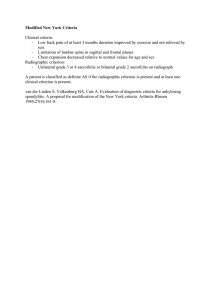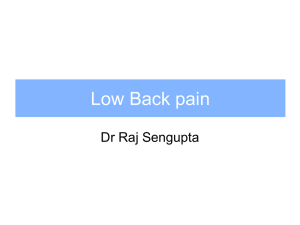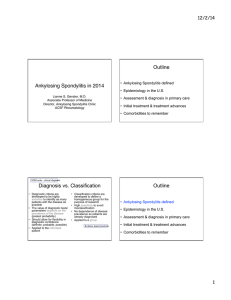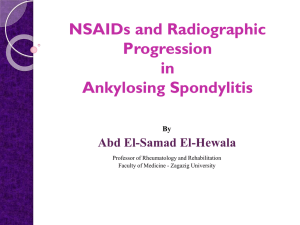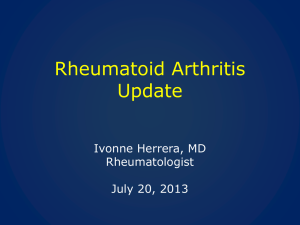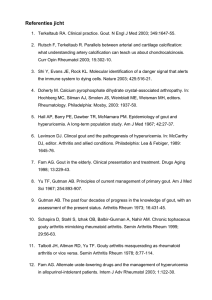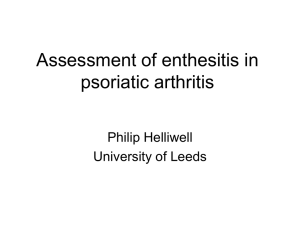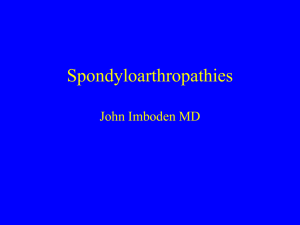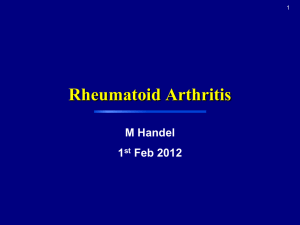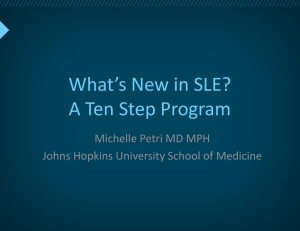Ankylosing Spondylitis
advertisement
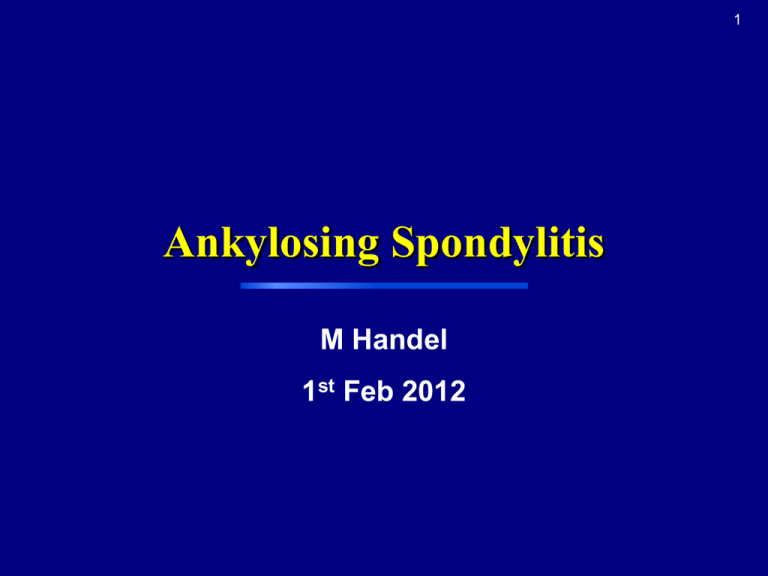
1 Ankylosing Spondylitis M Handel 1st Feb 2012 A Disease of Antiquity: Ankylosing Spondylitis • Amenhotep II (1439-1413 BC)1 • Rameses the Great (1298-1232 BC)1 1Rheumatol Int. 2003; 23:1-5. 2 3 Ankylosing Spondylitis (AS) • AS is a chronic, progressive immune-mediated inflammatory disorder that results in ankylosis of the vertebral column and sacroiliac joints1 • The spine and sacroiliac joints are the common affected sites1 – Chronic spinal inflammation (spondylitis) can lead to fusion of vertebrae (ankylosis)1 1 Taurog JD. et al. Harrison‘s Principles of Internal Medicine, 13 th Ed. 1994: 1664-67. Ankylosing Spondylitis “Bamboo Spine” Repeated process of healing and bone formation leads to formation of syndesmophytes ‘bone bridges’ ACR Slide Collection on the Rheumatic Diseases; 3rd edition. 1994. 4 5 Bridging syndesmophytes Intended for internal use only. Subject to local regulatory review prior to external use. AS: A Debilitating Rheumatic Disease Over time, joints in the spine can fuse together and cause a fixed, bent-forward posture AS patients have an important impact on health care and non health-care resource utilization, resulting in a mean total cost (direct and productivity) of about $6700 to $9500/year/patient1 More than 30% of patients carry a heavy burden of disease and have a decreased QoL2 1Linden VD et al. Chapter 10. In: Firestein, Budd, Harris, McInnes, Ruddy and Sergent, eds. Kelley’s Textbook of Rheumatology: Spondyloarthropathies. 8th ed. Saunders Elsevier;2009:p.1171 2 Braun J & Sieper. J Rheumatology 2008;47:1738-40 7 AS (“Mis-”) Perceptions • “Rare” • 0.1-0.9%1,2 • “Not” a serious disease, functional limitation is mild • Burden of disease significant in pain, sick leave, early retirement3,4,5 • “Rarely shortens life” • Mortality figures parallel RA6,7,8 1 Sieper J et al. Ann Rheum Dis. 2002; 61 (suppl 3);iii8-18. RC., Arthritis Rheum 1998; 41:778-99. 3 Zink A., et al., J Rheumatol 2000; 27:613-22. 4 Boonen A. Clin Exp Rheumatol. 2002;20(suppl 28):S23-S26. 5 Gran JT, et al. Br J Rheumatol. 1997;36:766-771. 2 Lawrence 6 Wolfe F., et al. Arthritis Rheum. 1994 Apr;37(4):481-94. Myllykangas-Luosujarvi R, et al. Br J Rheumatol. 1998;37:688-690. 8 Khan MA, et al. J Rheumatol. 1981;8:86-90. 9 Braun J., Pincus T., Clin Exp Rheumatol. 2002; 20(6 Suppl 28):S16-22. 7 8 Epidemiology of AS • The incidence of AS may be underestimated due to unreported cases1 • HLA-B27 gene is associated with AS6 • Age of onset typically between 15 and 35 years1,2,3 • 2-3 times more frequent in men than in women6 1The Spondylitis Association of America. Available at: www.spondylitis.org. Accessed December 2,2004. 61(suppl 3);iii8–18. 6Khan MA. Ann Intern Med. 2002;136:896–907. Intended for internal use only. Subject to local regulatory review prior to external use. SpA and HLA-B27 Disease AS Reactive arthritis (ReA) Juvenile spondyloarthropathy Approximate Prevalence of HLA-B27 (%) 90 40-80 70 Enteropathic spondyloarthropathy 35-75 Psoriatic arthritis 40-50 Undifferentiated spondyloarthropathy 70 Acute anterior uveitis 50 Aortic incompetence with heart block 80 Khan MA. Ann Intern Med 2002;136(12):896-907 Percentage of Patients (%) Intended for internal use only. Subject to local regulatory review prior to external use. Age at Onset Distribution of AS and Rheumatoid Arthritis (RA) AS Economically active individuals with a major impact on their ability to work1 RA 1Barkham N et al. Rheumatology 2005;44:1277-1281 A et al. Ann Rheum Dis 2001;60:199-206 2Zink Intended for internal use only. Subject to local regulatory review prior to external use. AS: Characteristic Pathologic Features • Chronic inflammation in: – Axial structures (sacroiliac joint, spine, anterior chest wall, shoulder and hip) – Possibly large peripheral joints, mainly at the lower limbs (oligoarthritis) – Entheses (enthesitis) • Bone formation particularly in the axial joints Inflammation Structural damage Disease activity Syndesmophytes formation Sieper J. Arthritis Res Ther 2009;11:208 Elewaut D & Matucci MC. Rheumatology 2009;48:1029-1035 Intended for internal use only. Subject to local regulatory review prior to external use. Inflammation AS: Signs and Symptoms Disease activity Axial manifestations: MRI sacro-iliac joint • Chronic low back pain • With or without buttock pain • Inflammatory characteristics: – Occurs at night (second part) – Sleep disturbance – Morning stiffness Inflammatory back pain (IBP) = Characteristic symptom • Limited lumbar motion • Onset before age of 40 years Sengupta R & Stone MA. Nat Clin Pract Rheumatol 2007;3:496-503 Hultgren S et al. Scand J Rheumatol 2000;29:365-369 Linden VD et al. Chapter 10. In: Firestein, Budd, Harris, McInnes, Ruddy and Sergent, eds. Kelley’s Textbook of Rheumatology: Spondyloarthropathies. 8th ed. Saunders Elsevier;2009:p.1175 Intended for internal use only. Subject to local regulatory review prior to external use. Structural damage AS: Structural Damage Syndesmophytes formation Most striking feature of AS = New bone formation in the spine with: • Spinal syndesmophytes • Ankylosis X-ray showing syndesmophytes Both can be seen on conventional radiography Even in patients with longerstanding disease, syndesmophytes are present in ~50% patients and a smaller percentage will develop ankylosis Bamboo spine and bilateral sacroiliitis Sieper J. Arthritis Res Ther 2009;11:208 Marginal erosions and new bone formation Unilateral sacroiliitis Intended for internal use only. Subject to local regulatory review prior to external use. AS: Signs and Symptoms Peripheral manifestations Enthesitis 50% patients with enthesitis1 Peripheral arthritis Up to 58% patients ever had arthritis1 1Cruyssen Dactylitis Much smaller number of patients2 BV et al. Ann Rheum Dis 2007;66:1072-1077 PI et al. Rheumatology 2008;47:355-361 2Sidiropoulos Intended for internal use only. Subject to local regulatory review prior to external use. Why are Dactylitis and Enthesitis Important? Likelihood of erosions is higher for digits with dactylitis than those without1 The first abnormality to appear in swollen joints associated with spondyloarthropathies is an enthesitis2 1Brockbank. Ann Rheum Dis 2005;62:188-90; et al. The Lancet 1998;352. 2McGonagle Intended for internal use only. Subject to local regulatory review prior to external use. AS: Extra-skeletal Signs and Symptoms Other common symptoms seen during the early stages of disease include: • Anorexia • Malaise • Low grade fever • Weight loss • Fatigue Fatigue is a frequent complaint of patients with AS1 1Missaoui B. et al. Ann Readapt Med Phys 2006;49:305-8, 389-391 Linden VD et al. Chapter 10. In: Firestein, Budd, Harris, McInnes, Ruddy and Sergent, eds. Kelley’s Textbook of Rheumatology: Spondyloarthropathies. 8th ed. Saunders Elsevier;2009:p.1176 Intended for internal use only. Subject to local regulatory review prior to external use. AS: Extra-articular Manifestations (EAM) EAM Anterior uveitis Cardiac abnormalities Prevalence in AS Patients (%) Anterior uveitis 30-50 IBD 5-10 Subclinical inflammation of the gut 25-49 Cardiac abnormalities Conduction disturbances Aortic insufficiency 1-33 1-10 Psoriasis 10-20 Renal abnormalities 10-35 Lung abnormalities Airways disease Interstitial abnormalities Emphysema 40-88 82 47-65 9-35 Bone abnormalities Osteoporosis Osteopenia 11-18 39-59 Terminal ileitis Elewaut D & Matucci MC. Rheumatology 2009;48:1029-1035 • Bad QoL1 – – – – – Percentage of Patients (%) Intended for internal use only. Subject to local regulatory review prior to external use. AS: Quality of life Pain Sleep problems Fatigue Loss of mobility and dependency Loss of social life • Effect employability1 1 ASAS=23.7 mean duration: years 23.7 yr 100 90.2 83.1 80 62.4 60 54.1 40 20 0 Stiffness • Higher rate of mortality 2 Pain Fatigue N=175 Poor Sleep High socio-economic consequences 1Adapted from Ward M. Arthritis Care & Res 1999;12:247-254 J. Clin Exp Rheumatol 2002;20(suppl 28):S16-22 2Braun 21 Ankylosing Spondylitis Classification 100 Percentage of Patients (%) Intended for internal use only. Subject to local regulatory review prior to external use. Delay in Diagnosis of AS First symptoms 80 First diagnosis 60 Average delay in diagnosis: 8.8 years B27(+) 8.5 vs B27(-) 11.4 40 20 0 Males (n=920) Females (n=476) 0 10 20 30 40 50 60 70 Age in years Delay Worse clinical outcomes contributing to both physical and work-related disability Adapted from Feldtkeller E et al. Rheumatol Int 2003;23:61–66 Sengupta R & Stone MA. Nat Clin Pract Rheumatol 2007;3:496-503 23 Diagnosis of AS • Modified New York Criteria for AS1 – Low back pain > 3 months (improved by exercise and not relieved by rest) – Limitation of lumbar spinal motion in sagittal and frontal planes – Chest expansion decreased relative to normal – Bilateral sacroilitis grade 2-4 or unilateral sacroilitis grade 3 or 4 • Detection of sacroilitis via X-ray or MRI1 – MRI can be used for earlier detection of inflammation (enthesitis) at other sites. • There is no specific laboratory test for AS1 – ESR and CRP can indicate inflammation • 50-70% of active AS patients will have increased ESR and CRP2 – Rheumatoid factor is not associated with AS – HLA-B27 1Khan M, Ankylosing Spondylitis-the facts; 2002:Oxford University Press:94-98. 2Sieper J, et al. Ann Rheum Dis. 2002;61(Suppl 8). Intended for internal use only. Subject to local regulatory review prior to external use. Diagnostic Standard for AS: Modified NY Classification Criteria (1984)1 • Clinical components: – Low back pain and stiffness for more than 3 months which improves with exercise, but is not relieved by rest • Old criteria – Limitation of• motion the lumbar spine in both the sagittal Definedof before TNF blockers and frontal planes • Sacroiliitis detectable by X-ray occurs – lately Limitation of chest expansion relative to normal values • age No magnetic correlated for and sexresonance imaging (MRI) • Used for clinical trial • Radiological component: – Sacroiliitis Grade >2 bilaterally or Grade 3-4 unilaterally Definite AS if the radiological criterion is associated with at least one clinical criterion2 Probable AS if three clinical criteria present or radiologic criteria present without clinical criteria2 1 Linden VD et al. Arthritis Rheum 1984;27:361-368 M et al. Arthritis Rheum 2005;52:1000-1008 2Rudwaleit Intended for internal use only. Subject to local regulatory review prior to external use. Diagnostic Standard for AS: Modified NY Classification Criteria (1984) (Cont’d) Radiographic stage (Ankylosing Spondylitis) Back Pain Radiographic sacroiliitis Back Pain Syndesmophytes Modified NY criteria (1984) Time (years) The greatest problem in the management of AS was the lack of effective treatments. In recent years, NSAIDs and TNF-blockers have been shown to have good efficacy in the treatment of AS. Adapted from Rudwaleit M et al. Arthritis Rheum 2005;52:1000-1008 Brandt HC et al. Ann Rheum Dis 2007;66:1479-84 Intended for internal use only. Subject to local regulatory review prior to external use. Diagnostic Standard for AS: Modified NY Classification Criteria (1984) (Cont’d) Pre-radiographic stage (Axial undifferentiated SpA) Radiographic stage (Ankylosing Spondylitis) Back Pain Back Pain IBP MRI active sacroiliitis Radiographic sacroiliitis Back Pain Syndesmophytes Modified NY criteria (1984) Time (years) • Recent application of MRI techniques has demonstrated (and confirmed) that ongoing active (“acute”) inflammation in fact does occur in the sacroiliac joints and/or spine prior to the appearance of changes detectable radiographically • The presence and absence of radiographic sacroiliitis in patients with SpA represent different stages of a single disease continuum Adapted from Rudwaleit M et al. Arthritis Rheum 2005;52:1000-1008 27 Spondyloarthritis and Classification Criteria Spondyloarthropathies Axial and Peripheral AMOR criteria (1990) ESSG criteria (1991) Axial Spondyloarthritis Peripheral Spondyloarthritis ASAS classification 2009 ASAS classification 2010 Ankylosing spondylitis Prototype of axial spondylitidis Modified New York criteria 1984 Infliximab (IFX) and Golimumab (GLM) indications Psoriatic arthritis From Moll & Wright 1973 to CASPAR criteria 2006 ESSG: European Spondyloarthropathy Study Group ASAS: Assessment of Spondyloarthritis International Society CASPAR: Classification criteria for psoriatic arthritis Sieper et al. Ann Rheum Dis 2009;68:ii1-ii44 Taylor et al. Arthritis & Rheum 2006;54:2665-73 Van der Heijde et al. Ann Rheum Dis 2011;70:905-8 Intended for internal use only. Subject to local regulatory review prior to external use. ASAS Classification Criteria for Axial SpA In patients with back pain ≥3 months and age at onset <45 years Sacroiliitis* on imaging plus HLA-B27 OR plus ≥1SpA feature** *Sacroiliitis on imaging: • Active (acute) inflammation on MRI highly suggestive of sacroiliitis associated with SpA or • Definite radiographic sacroiliitis according to modified New York criteria ≥2 other SpA features** **SpA features: • • • • • • • • • • • Inflammatory back pain Arthritis Enthesitis (heel) Uveitis Dactylitis Psoriasis Crohn’s disease/ulcerative colitis Good response to NSAIDs Family history for SpA HLA-B27 Elevated CRP Rudwaleit M et al. Ann Rheum Dis 2009;68(6):770-6 29 Ankylosing Spondylitis Response Criteria ASAS Working Group Criteria for Response 30 • Patients will be categorized as an ASAS 20 responder if the patient achieves the following: – >20% improvement from baseline and absolute baseline improvement of >10 (on a 0-100mm scale) in at least 3 of the following 4 domains: • Patient global assessment • Spinal pain • Function (BASFI) • Inflammation – Average of the last 2 BASDAI questions concerning level and duration of morning stiffness – No deterioration from baseline (>20% and absolute change of at least 10 on a 0-100 mm scale) in the potential remaining domain Anderson JJ, et al. Arthritis Rheum. 2001;44(8):1876–1886. Bath Ankylosing Spondylitis Disease Activity Index (BASDAI) 31 • The BASDAI is measured using the following VAS (0 to 10 cm) of subject self-assessments: • Fatigue • Spinal pain • Joint pain • Enthesitis • Inflammation – Duration morning stiffness – Severity morning stiffness Garrett S, et al. J Rheumatol. 1994;21:2286–2291.
